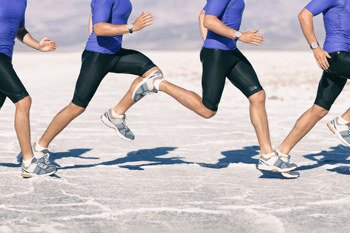 If you have adopted running or jogging as a hobby, you most likely know the benefits of choosing shoes that fit your feet perfectly. There are different parts of running shoes, including the upper portion, which is typically the entire part of the shoe above the sole. When a shoe is chosen that is the same shape as your foot, running may be accomplished with ease and satisfaction. The part of the shoe that is located in back of the laces is referred to as the ankle collar. This is the portion of the shoe that is responsible for holding the heel in place. The heel counter is found in the heel of the shoe and will generally provide stability while landing on the foot. The saddle is known to protect the arch of the foot by reinforcing this area, in addition to holding the foot securely in the shoe. Lastly, the outsole is comprised of material that is on the bottom of the shoe, and provides the necessary traction for efficient running. If you would like additional information about how to choose the correct running shoe, please consult with a podiatrist who can properly advise you.
If you have adopted running or jogging as a hobby, you most likely know the benefits of choosing shoes that fit your feet perfectly. There are different parts of running shoes, including the upper portion, which is typically the entire part of the shoe above the sole. When a shoe is chosen that is the same shape as your foot, running may be accomplished with ease and satisfaction. The part of the shoe that is located in back of the laces is referred to as the ankle collar. This is the portion of the shoe that is responsible for holding the heel in place. The heel counter is found in the heel of the shoe and will generally provide stability while landing on the foot. The saddle is known to protect the arch of the foot by reinforcing this area, in addition to holding the foot securely in the shoe. Lastly, the outsole is comprised of material that is on the bottom of the shoe, and provides the necessary traction for efficient running. If you would like additional information about how to choose the correct running shoe, please consult with a podiatrist who can properly advise you.
If you are a runner, wearing the right running shoe is essential. For more information, contact Dr. Tina Oliver from Astro Foot Care, PA. Our doctor can provide the care you need to keep you pain-free and on your feet.
Choosing the Right Running Shoe for Your Foot Type
To increase performance and avoid the risk of injury, it is important to choose the right running shoe based on your foot type. The general design of running shoes revolves around pronation, which is how the ankle rolls from outside to inside when the foot strikes the ground.
If you have any questions please feel free to contact our office located in Houston, TX. We offer the newest diagnostic and treatment technologies for all your foot and ankle needs.
Read more about Choosing the Right Running Shoe for Your Foot Type